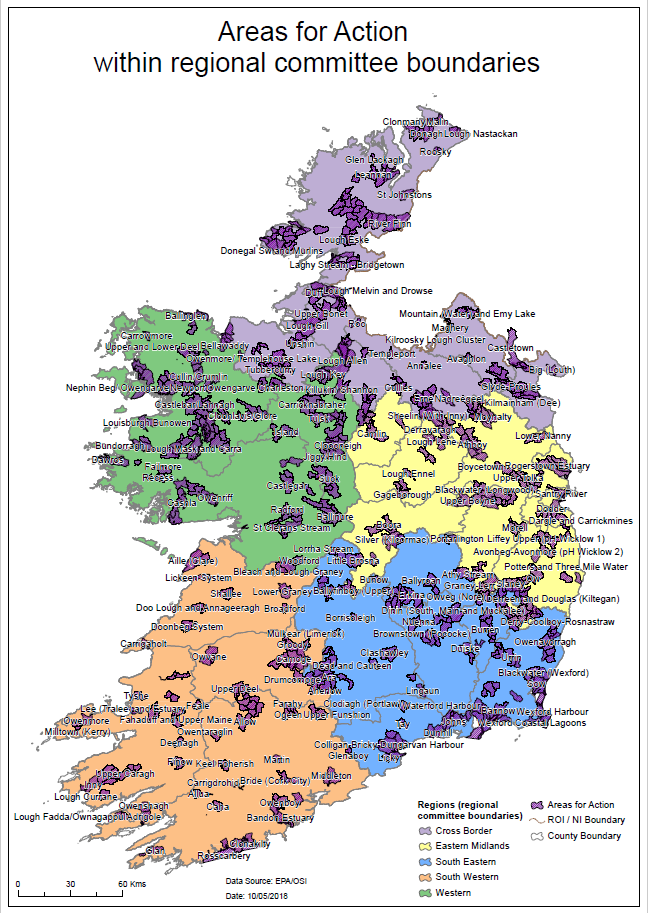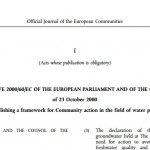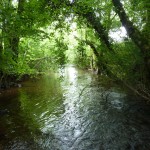In 2014, the Minister for the Environment introduced the European…
Understanding our catchments: Water Framework Directive characterisation
In this article from the Winter 2018 Catchments Newsletter, Jenny Deakin from the EPA Catchments Unit outlines how we carried out the characterisation process for the 2nd Cycle of the Water Framework Directive, what we’ve learned, and how this knowledge and insight is informing action.
Every 6 years, Ireland produces a plan for how we are going to protect and restore the quality of all our waters – rivers, lakes, groundwaters, estuaries and coastal waters. To develop a plan, we need to understand what is happening within our catchments, a process called characterisation.
Simply put, characterisation means finding out where the problems are, what is causing them and why, and how we can fix them. Resources will always be limited, so it is important that the focus is on key actions that will improve water quality and provide the best return for the investment. It is a key principle for this cycle that we target the right measure in the right place.
What is the scale of the problem?
For this cycle, Ireland has one national river basin district (RBD) and two international RBDs. The country has been divided up into 46 catchments, which are made up of 583 subcatchments, which in turn encompass a total of 4,829 waterbodies.
The first step was to determine which water bodies are At Risk of not achieving their Water Framework Directive objectives (Figure 1). Water bodies that are At Risk require action, which means spending money. It is therefore important that there is sufficient evidence to justify that spend.
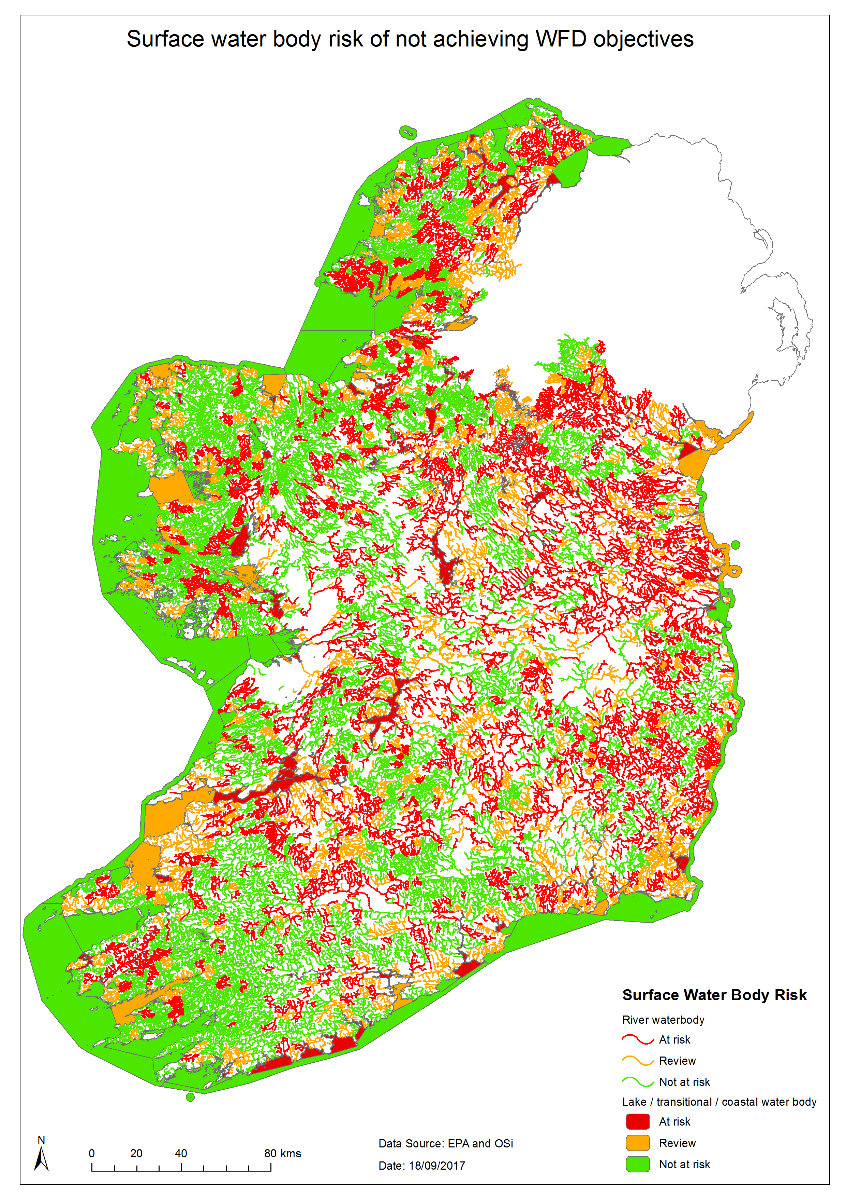 Risk has therefore been determined on the basis of the evidence from the monitoring data.
Risk has therefore been determined on the basis of the evidence from the monitoring data.
- Water bodies that are At Risk had either not achieved their objectives by 2015, or had achieved their objectives but the trend data indicates that they are deteriorating and that further action is required.
- Water bodies that are Not at Risk have achieved their objectives and have either no significant trends, or improving trends.
- Water bodies in Review have insufficient information to determine the risk, or have had measures implemented but some additional monitoring is required to confirm that the expected improvements have been achieved.
Approximately 30% of all water bodies are At Risk of not achieving their WFD objectives and need further action (Figure 2). Transitional waters (estuaries) and rivers have the greatest challenges. The main water quality problem is eutrophication which is caused by the loss of excess nutrients, mainly phosphorus in our rivers and lakes, and nitrogen in our estuaries. Sediment is also a problem in places, particularly in high status waters, as well as physical modification (hydromorphology) of rivers and lakes.
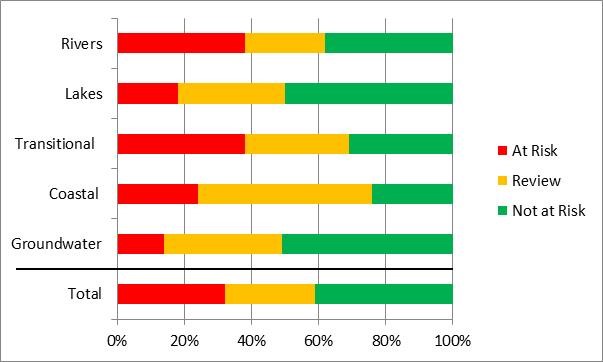 It is important to note that waterbodies that are currently Not at Risk could still deteriorate in the future, and they therefore need ongoing protection, including implementation of best practice management strategies, and prevention of accidents, such as slurry spills or operational issues at waste water treatment plants, for example.
It is important to note that waterbodies that are currently Not at Risk could still deteriorate in the future, and they therefore need ongoing protection, including implementation of best practice management strategies, and prevention of accidents, such as slurry spills or operational issues at waste water treatment plants, for example.
What are the Significant Pressures causing the impacts?
There are many pressures in the catchment areas of all water bodies, but not all of them are significant. Significant pressures are those pressures that are having a significant impact on ecological status and need to be addressed before the status will improve. Significant pressures are only identified therefore for water bodies that are At Risk of not achieving their objectives.
The assessment to identify which pressures are significant has been extensive, involving almost 50-person years worth of work, over 140 datasets, a range of modelling tools, local information and experience from local authority and Inland Fisheries Ireland staff which was contributed through a series of county-based discussion workshops, and peer review by the relevant pressure regulators.
You can read a summary of some of the significant pressures on pages 28 – 38 of this Newsletter. You can also view the significant pressures on our water bodies on www.catchments.ie/maps
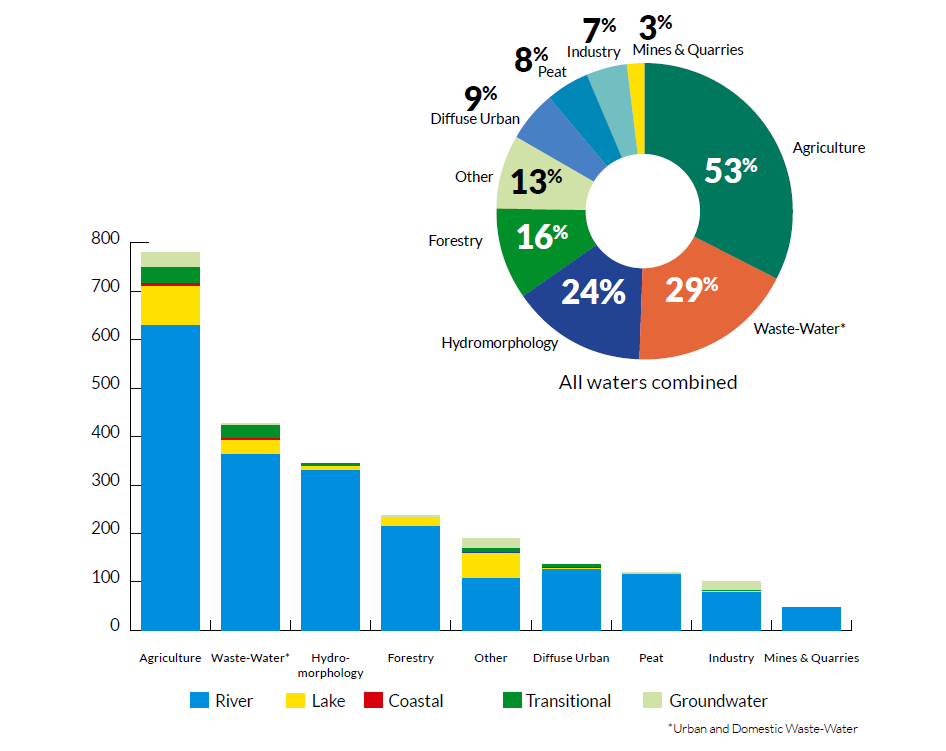 Agriculture is the most prevalent significant pressure impacting on At Risk water bodies (53%), which is not surprising given that agriculture is also the most prevalent land use. The other most significant pressures include hydromorphology (24%), urban wastewater (20%), forestry (16%), domestic wastewater (11%), urban runoff (9%), peat extraction and drainage (8%) and industry (7%) (Figure 3). Approximately half of all water bodies that are At Risk are impacted by more than one pressure.
Agriculture is the most prevalent significant pressure impacting on At Risk water bodies (53%), which is not surprising given that agriculture is also the most prevalent land use. The other most significant pressures include hydromorphology (24%), urban wastewater (20%), forestry (16%), domestic wastewater (11%), urban runoff (9%), peat extraction and drainage (8%) and industry (7%) (Figure 3). Approximately half of all water bodies that are At Risk are impacted by more than one pressure.
Measures
The Catchments Unit has used the source-pathway-receptor framework in the characterisation process which is also the first step towards identifying the most appropriate measures. For example, measures can be targeted at the source, the pathway or the receptor:
- Source control: The most commonly applied measures in Ireland and elsewhere are applied at the source, as this is the point at which activities are carried out and regulated. This approach works well for large point sources, but is generally not sufficiently effective on its own for diffuse sources.
- Repair the receptor: Restoration of receptors are most commonly used in Ireland for treating drinking waters to the required standard, or for restoring fish habitat after channel maintenance activities. However, these measures are often expensive, and focus on the symptoms in an impacted water body rather than the cause.
- Break the pathway: For diffuse sources of contamination, particularly where contaminants are delivered to receptors via overland flow pathways, which are activated during rainfall events, it may be far more effective to intercept the transport pathway. This is especially useful where phosphorus is the issue because it takes a very, very small proportion of the amounts of phosphorus that are used in agricultural production to be lost to cause an ecological water quality problem. Relying only on source control in this instance is unlikely to be an effective solution.
Priority Areas for Action
The large number of water bodies requiring further action means there is a need to prioritise where action is focussed. The EPA and the Local Authority Waters and Communities Office (LAWCO) jointly led a collaborative workshop process involving Local Authority personnel and all public bodies with an interest in water to decide, at a regional level, which water bodies should be prioritised as Areas for Action.
The decision process was based on the priorities in the River Basin Management Plan, the evidence from the characterisation process, expertise, data and knowledge of public body staff, and local priorities such as amenity value. The River Basin Management Plan has consequently identified 190 Areas for Action across the country, which includes a total of 726 water bodies. Public engagement and feedback sessions on the Areas for Action was then carried out by The Local Authority Water and Communities Office (LAWCO). You can find out where these areas are, and the reasons for their selection, at www.catchments.ie/areas-for-action/
What actions will be carried out?
In 2018, the Local Authority Waters Programme Catchment Assessment Team was established to carry out Local Catchment Assessments within the 190 Areas for Action. The purpose of the Local Catchment Assessments is to carry out catchment, stream, street and shore walks to figure out precisely what the problems are at the field scale, what the options are for addressing them and how best to get appropriate actions implemented. Ten regional offices have been established and 35 new scientists will be doing the work. The Catchment Assessment Teams will also be working closely with other public bodies that have local knowledge and expertise and can contribute to getting actions implemented.
The Catchments Unit, together with a working group made up of 25 representatives from different relevant public bodies, has developed a comprehensive local catchment assessment guidance manual to support these local activities. A comprehensive associated training programme has also been developed and rolled out to all the new staff.
How will the measures be implemented?
A key part of this work will be working with local landowners. This work will be carried out by another new organisation, the Agricultural Sustainability Support and Advice Service (ASSAP). This advisory programme has 20 Teagasc Advisors, funded by the Department of Agriculture, Food and Marine and the Department of Housing, Planning and Local Government, and 10 specialist dairy advisors, funded by the dairy industry.
ASSAP will work on a voluntary and collaborative basis with farmers in Areas for Action. These advisors have extensive experience, and will work
directly with farmers and their existing advisors. They will work on farm level action plans – looking at yards, lands and nutrient management planning. Other public bodies, for example the Forest Service, Inland Fisheries Ireland, EPA and local authority staff, will play an important role in helping the Catchment Assessment Teams to get actions implemented.
The Waters and Communities Team will be supporting the Catchment Assessment team by working with local communities to engage with their local waterways, talk about their catchments and what is happening, and harness local knowledge. Community buy-in will be essential for getting measures implemented and for protecting local water resources for the long term.
A key part of all this work in Areas for Action will be identifying any grants or supports available to help people to make changes where necessary, to help improve their local waters – whether that is a homeowner who wants to fix a septic tank, or a farmer fencing off watercourses and putting in drinking troughs.
What is next?
Now that the 2nd cycle is well underway, we are starting to turn our attention towards characterisation for the third cycle. In particular, we would like to better understand some of the key scientific questions that have arisen during the process thus far so that we can better target the actions in the next cycle.
For example, approximately 400 water bodies improved during the last cycle, so what has happened in their catchments to effect that change?
Similarly, approximately 500 water bodies have deteriorated, so what learnings can we glean from them and how can we reduce this level of decline?
There have also been significant and worrying losses of our highest quality status sites which are so important for biodiversity, for recolonisation of degraded sites lower downstream in these catchments, and to provide our reference conditions. What is causing these losses and how can we protect
them into the future?
Working together, to achieve more
Between now and 2021, Ireland faces significant challenges to achieve the water quality outcomes set out in the River Basin Management Plan. Considerable resources are being invested in carrying out field scale Local Catchment Assessments in our 190 Areas for Action, and in supports to help farmers and local communities find local solutions.
This is a major change in comparison to the first cycle where the approach was just to rely on enforcement of the ‘one size fits all’ national regulations.
Awareness raising, engagement, change of practice, and supports are the main focus of this new approach. Expected outcomes include 726 water bodies achieving general water quality improvements, and 152 water bodies experiencing improved water quality status.
Some of the problems we face are very challenging – most especially, for diffuse sources of pollution, for which there are multiple and diverse land holders, multiple problems, multiple agencies and players, multiple (and often conflicting) messages, and lack of resources in households or farms.
Local, specific and tailored advice will be critical. We will not need new measures everywhere – but the one size fit all approaches are not the full solution. We will all need to work together, and try and make sure that we can achieve the right measure, in the right place.


